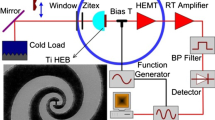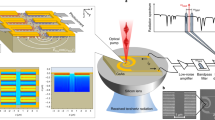Abstract
Low noise terahertz (THz) heterodyne detectors based on superconducting niobium nitride (NbN) hot electron bolometers (HEBs) have been studied. The HEB consists of a planar antenna and an NbN bridge connecting across the antenna’s inner terminals on a high-resistivity Si substrate. The double sideband noise temperatures at 4.2 K without corrections have been characterized from 0.65 to 3.1 THz. The excess quantum noise factor β of about 4 has been obtained, which agrees well with the calculated value. Allan variance of the HEB has been measured, and Allan time up to 20 s is obtained using a microwave feedback method. Also, the intermediate frequency gain bandwidth (GBW) was measured using two different methods, resulting in same GBW value of about 3.5 GHz.
Similar content being viewed by others
References
Liang M, Chen J, Kang L, et al. Low noise receivers based on superconducting niobium nitride hot electron bolometer mixers from 0.65 to 3.1 terahertz. IEICE Trans Electron, 2010, E93-C: 473–479
Hübers H W. Terahertz heterodyne receivers. IEEE J Sel Topic Quantum Electron, 2008, 14: 378–391
Dochev D, Desmaris V, Meledin D, et al. A technology demonstrator for 1.6–2.0 THz waveguide HEB receiver with a novel mixer layout. J Infrar Millim Terahertz Wave, 2011, 32: 451–465
Cherednichenko S, Drakinskiy V, Berg T. Hot-electron bolometer terahertz mixers for the Herschel space observatory. Rev Sci Instr, 2008, 79: 034501
Wu P H, Kang L, Chen Y, et al. Fabrication and characterization of NbN/AlN/NbN junction on MgO(001) and AlN/NbN bilayer on MgO(111) substrates. IEEE Trans Appl Supercond, 2005, 15: 209–211
Chen J, Liang M, Kang L, et al. Low noise receivers at 1.6 THz and 2.5 THz based on niobium nitride hot electron bolometer mixers. IEEE Trans Appl Supercond, 2009, 19: 278–281
McCarthy D E. Black polyethylene as a far-infrared filter. J Opt Soc Am, 1967, 57: 699–670
Khosropanah P, Gao J R, Laauwen W M, et al. Low noise NbN hot electron bolometer mixer at 4.3 THz. Appl Phys Lett, 2007, 91: 221111
Kollberg E L, Yngvesson K S. Quantum-noise theory for terahertz hot electron bolometer mixers. IEEE Trans Microw Theory Tech, 2006, 54: 2077–2089
Hajenius M, Baselmans J J A, Baryshev A, et al. Full characterization and analysis of a terahertz heterodyne receiver based on a NbN hot electron bolometer. J Appl Phys, 2006, 100: 074507
Chen J, Jiang Y, Liang M, et al. Stability of superconducting hot electron bolometer receivers. IEEE Trans Appl Supercond, 2011, 21: 667–670
Berg T, Cherednichenko S, Drakinskiy V, et al. Stability of HEB receivers at THz frequencies. Proc SPIE, 2004, 5498: 605–614
Ekstrom H, Karasik B S, Kollberg E L. Conversion gain and noise of niobium superconducting hot-electron mixers. IEEE Trans Microw Theory Tech, 1995, 43: 938–947
Karpov A, Miller D A, Stern J A, et al. Low noise 1 THz SIS mixer for stratospheric observatory: Design and Characterization. IEEE Trans Appl Supercond, 2011, 21: 616–619
Burke P J, Schoelkopf R J, Prober D E, et al. Mixing and noise in diffusion and phonon cooled superconducting hot-electron bolometers. J Appl Phys, 1999, 85: 1644–1653
Author information
Authors and Affiliations
Corresponding author
Additional information
JIANG Yi was born in 1986. He is now a Ph.D. candidate in radio physics from Research Institute of Superconductor Electronics (RISE), Nanjing University (NJU), Nanjing. His research interests include terahertz spectrometer, terahertz detectors and terahertz imaging.
WU PeiHeng was born in 1939. He graduated from NJU in 1961 majoring in physics. He has been a Professor in NJU since 1985 and an academician, Chinese Academy of Sciences (CAS) since 2005. From January 2001 to July 2001, he was a professor in RIEC, Tohoku University, Japan. His research interest includes superconducting electronics, high frequency techniques and their applications.
CHEN Jian was born in 1963. He received the B.S. and M.Sc. degrees in radio physics from NJU, in 1983 and 1986, respectively. From 1986 to 1989, he was an assistant in NJU. He received DE degree in Department of Electrical Engineering from Nagaoka University of Technology (NUT), Japan, in 1992. Then, he was an assistant in Research Institute of Electrical Communication (RIEC), Tohoku University, Japan. From 1998, he was an associate professor in RIEC. He has been a professor in NJU since 2003. He is a senior member of IEEE. His research interest includes superconducting devices and their applications.
Rights and permissions
About this article
Cite this article
Jiang, Y., Jin, B., Xu, W. et al. Terahertz detectors based on superconducting hot electron bolometers. Sci. China Inf. Sci. 55, 64–71 (2012). https://doi.org/10.1007/s11432-011-4513-3
Received:
Accepted:
Published:
Issue Date:
DOI: https://doi.org/10.1007/s11432-011-4513-3




